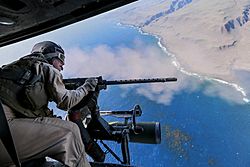Naval Auxiliary Landing Field San Clemente Island facts for kids
Quick facts for kids Naval Auxiliary Landing Field San Clemente Island |
|||||||||
|---|---|---|---|---|---|---|---|---|---|
| Frederick Sherman Field | |||||||||
| Part of Naval Base Coronado | |||||||||
| San Clemente Island, California in the United States | |||||||||

A Marine engages targets from a UH-1Y Venom with VMM-161 during Composite Training Unit Exercise (COMPTUEX) above San Clemente Island
|
|||||||||
|
Location in the United States
|
|||||||||
| Coordinates | 33°01′22″N 118°35′19″W / 33.02278°N 118.58861°W | ||||||||
| Type | Naval Auxiliary Landing Field | ||||||||
| Site information | |||||||||
| Owner | Department of Defense | ||||||||
| Operator | US Navy | ||||||||
| Controlled by | Navy Region Southwest | ||||||||
| Condition | Operational | ||||||||
| Site history | |||||||||
| Built | 1937 | ||||||||
| In use | 1937 – present | ||||||||
| Garrison information | |||||||||
| Current commander |
Captain John DePree | ||||||||
| Airfield information | |||||||||
| Identifiers | ICAO: KNUC, FAA LID: NUC, WMO: 722925 | ||||||||
| Elevation | 56 metres (184 ft) AMSL | ||||||||
|
|||||||||
|
|||||||||
The Naval Auxiliary Landing Field (NALF) San Clemente Island is a special military airport. It is also known as Frederick Sherman Field. This airport is located on San Clemente Island in California, United States. The United States Navy has owned it since 1937. It is very important for Navy training today. It is the Navy's only place for live-fire training.
About San Clemente Island
San Clemente Island is the most southern of the Channel Islands. It covers about 57 square miles (150 km²). The island is about 21 nmi (39 km) long. At its widest, it is 4.5 nmi (8 km) across. It is located 55 nmi (102 km) south of Long Beach. It is also 68 nmi (130 km) west of San Diego.
What Happens Here?
San Clemente Island has always been important for the Navy. It helps them test new weapon systems. In 1939, the Navy created the first "Higgins Boat" here. This boat was a Landing Craft, Vehicle and Personnel (LCVP). It was a big step for the Naval Amphibious Force. This force played a key role in World War II.
Today, San Clemente Island has two main jobs. First, it supports training for the Pacific Fleet. Second, it continues as a key place for research and development. The island offers a special training area for the Navy and Marine Corps. They can practice different types of warfare here.
A lot of Navy training happens near the island's shores. The main training area is huge. It covers over 149,000 square miles (386,000 km²). This is the Navy's busiest airspace. The training area also includes places for mine exercises. There are also areas for anti-submarine training. Plus, there are seven submarine areas. There is a shallow water Undersea Training Range. Two laser training ranges are also here.
Overall, San Clemente Island is unique. It combines airfields, airspace, and training ranges. No other Navy facility is quite like it. It is the only place in the Pacific where different forces can train together. Surface ships, submarines, aircraft, and expeditionary forces can all train at once. They can practice shore gunnery and bombardment. They also practice air defense, antisubmarine warfare, and electronic warfare.
The station was named Frederick C. Sherman Field on January 11, 1961. It honors Vice Admiral Frederick C. Sherman. He received the Navy Cross three times for his bravery.
Helping the Environment
The Naval facility on San Clemente Island cares about the environment. They wanted to use less diesel fuel. They also wanted to stop harmful emissions. So, they put in three large wind turbines. Each turbine can make 225 kilowatts of power.
From February 1998 to April 2000, these turbines made a lot of electricity. They produced two GWh of power. This was about 13 percent of all the electricity the island needed. In 1999, the turbines helped save over 141,000 US gallons (537 m³) of diesel fuel. This also stopped over 18,000 pounds (8,369 kg) of carbon monoxide from going into the air. In the future, these turbines should provide 15 percent or more of the island's electricity. This will help even more with saving fuel and reducing pollution.


